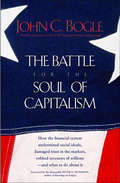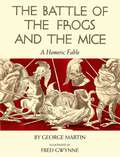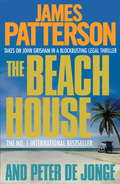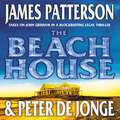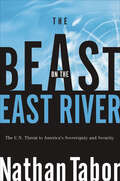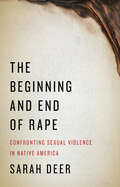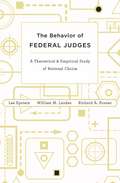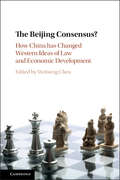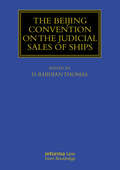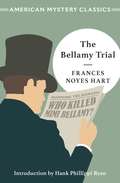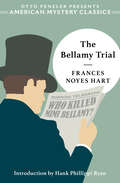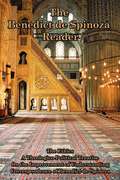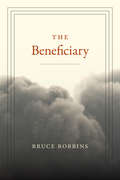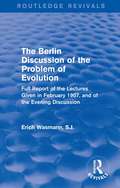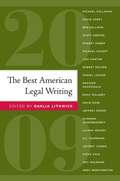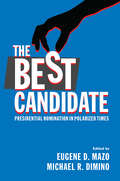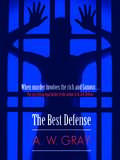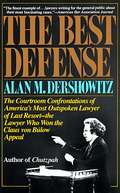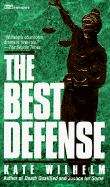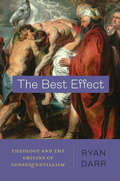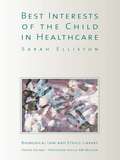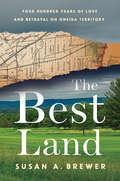- Table View
- List View
The Battle for the Soul of Capitalism: How the Financial System Undermined Social Ideals, Damaged Trust in the Markets, Robbed Investors of Trillions—and What to Do About It (Playaway Adult Nonfiction Ser.)
by John C. BogleThe legendary founder of Vanguard &“presents an insider&’s view of what&’s wrong with corporate America and what can be done to improve it&” (Burton G. Malkiel, author of A Random Walk Down Wall Street).New York Times-bestselling author of Enough and The Little Book of Common Sense Investing John Bogle has seen firsthand the innermost workings—and grotesque abuses—of the financial industry, and is renowned as an advocate for the small investor and for the restoration of integrity to the system. He knows that a trustworthy business and financial complex is essential to America&’s continuing leadership in the world and to social and economic progress at home. In this book he reveals what went wrong and how we lost our way—and more importantly, how we can right our course. He argues for a return to a governance structure in which owners&’ capital that has been put at risk is used in their interests rather than in the interests of corporate and financial managers. Given that ownership is now consolidated in the hands of relatively few large mutual and pension funds, the specific reforms Bogle details in this book are essential as well as practical—and should be considered by every investor, analyst, Wall Streeter, policy maker, and businessperson. &“Deserves attention in the precincts of power.&”—Publishers Weekly
The Battle of the Frogs and the Mice: A Homeric Fable
by George MartinYou will never see war the same way after reading this extraordinary retelling of an ancient Greek fable about a tragically unnecessary battle between mice and frogs. With haunting illustrations, this miniature masterpiece ranks with Animal Farm as one of the greatest parables of human foibles.Originally published in 1962, The Battle of the Frogs and the Mice tells in words and pictures a classic tale of the foolhardiness of war. When Crum-snatcher, a Mouse, cautiously mounts the back of Puff-jaw, King of the Frogs, to explore the Frogs’ pond, the Mouse meets with a disaster which soon brings the two nations into mortal conflict. The course of this tempest in a teapot is developed with wit to assume heroic proportions, and the battle of this small world becomes the story of wars through the ages.George Martin has made an imaginative, free adaptation of a fable originally ascribed to Homer, but now believed to have been written about three hundred years after him by an unknown author. The book’s events are brilliantly depicted by the drawings of Fred Gwynne, a versatile artist known for his role as Herman Munster in the sit-com hit The Munsters. Gwynne’s haunting and unsparingly illustrations portray this chronicle from its pastoral beginning to its bitter end. Together, Martin and Gwynne have made a book of grim delight for adults and young readers alike.
The Beach House
by James Patterson Peter De JongeThe second that Columbia law student Jack Mullen steps down from the train at East Hampton, he knows that something is very wrong. As he greets his family, his kid brother Peter lies stretched out on a steel gurney, battered, bruised - dead. The police are calling the drowning an accident. Jack knows that's not right. Someone wanted his brother dead.But the establishment says otherwise. Jack tries to uncover what really happened on the beach that night, only to confront a wall of silence; a barricade of shadowy people who protect the privileges of the multi-billionaire summer residents. And when he discovers that his brother had nearly $200,000 in his bank account, Jack realises Peter wasn't just parking cars to make a living...
The Beach House
by James Patterson Peter De JongeThe second that Columbia law student Jack Mullen steps down from the train at East Hampton, he knows that something is very wrong. As he greets his family, his kid brother Peter lies stretched out on a steel gurney, battered, bruised - dead. The police are calling the drowning an accident. Jack knows that's not right. Someone wanted his brother dead.But the establishment says otherwise. Jack tries to uncover what really happened on the beach that night, only to confront a wall of silence; a barricade of shadowy people who protect the privileges of the multi-billionaire summer residents. And when he discovers that his brother had nearly $200,000 in his bank account, Jack realises Peter wasn't just parking cars to make a living...(P)2012 Headline Digital
The Beast on the East River: The U.N. Threat to America's Sovereignty and Security
by Nathan TaborA call to arms for Americans to assert and preserve our national sovereignty by stopping the globalist agenda of the United Nations.Is the United Nations the benign force for good that so many proclaim? Or is there a darker agenda at work behind the scenes? Nathan Tabor reveals the sinister plan behind the glossy image of world cooperation painted by the UN and its defenders.The Beast on the East River includes original research into key policy areas, including population control, education, and the international criminal court. And it offers practical steps that concerned American citizens can take before it’s too late.In his debut book, rising conservative voice Nathan Tabor offers a frightening exposé of the United Nations’ global power grab and its ruthless attempt to control US education, law, gun ownership, taxation, and reproductive rights.“We are already very nearly at the point of no return,” says Tabor, “and most Americans aren’t even aware of the impending danger. This book is a call to immediate action—read its contents very carefully. What you will discover may surprise and anger you.”“His book provides a measured intellectual argument against allowing the corrupt collectivist internationalists of the UN, and its many metastasized affiliates, to undermine and eventually steal one of America’s most precious possessions: its sovereignty.” —Henry Mark Holzer, CBN (The Christian Broadcasting Network)
The Bedroom and the State: The Changing Practices and Politics of Contraception and Abortion in Canada, 1880-1997 (2nd edition)
by Angus Mclaren Arlene T. MclarenThe decline of the birth rate is arguably the most important social change of the twentieth century in Canada. The Bedroom and the State, first published in 1986, examines the social, cultural, and technological reasons for this decline and answers such questions as:* What forms of contraception were used prior to the Pill?* How widespread and dangerous has abortion been?* Why were so many feminists, socialists, ministers, and doctors initially opposed to birth control?* Who were its first proponents in Canada?* Why has Quebec's birth rate fallen so precipitiously?* Why was contraception illegal until 1969?The Bedroom and the State is recognized as a landmark history of how Canadian men and women sought to limit births and how public figures sought to turn such concern to political purposes. In this second edition the authors have updated their conclusion and added a new chapter to cover denouementof the pro-choice/pro-life debate in Canada, to detail recent court challenges to Canadian law, and to describe recent developments in reproductive technologies and their significance for present and future generations.This excellent work reveals that the control of fertility has been a crucial factor in the history of the shifting power relationships of the sexes and the classes.
The Beginning and End of Rape: Confronting Sexual Violence in Native America
by Sarah DeerWinner of the Labriola Center American Indian National Book Award Despite what major media sources say, violence against Native women is not an epidemic. An epidemic is biological and blameless. Violence against Native women is historical and political, bounded by oppression and colonial violence. This book, like all of Sarah Deer&’s work, is aimed at engaging the problem head-on—and ending it.The Beginning and End of Rape collects and expands the powerful writings in which Deer, who played a crucial role in the reauthorization of the Violence Against Women Act in 2013, has advocated for cultural and legal reforms to protect Native women from endemic sexual violence and abuse. Deer provides a clear historical overview of rape and sex trafficking in North America, paying particular attention to the gendered legacy of colonialism in tribal nations—a truth largely overlooked or minimized by Native and non-Native observers. She faces this legacy directly, articulating strategies for Native communities and tribal nations seeking redress. In a damning critique of federal law that has accommodated rape by destroying tribal legal systems, she describes how tribal self-determination efforts of the twenty-first century can be leveraged to eradicate violence against women. Her work bridges the gap between Indian law and feminist thinking by explaining how intersectional approaches are vital to addressing the rape of Native women.Grounded in historical, cultural, and legal realities, both Native and non-Native, these essays point to the possibility of actual and positive change in a world where Native women are systematically undervalued, left unprotected, and hurt. Deer draws on her extensive experiences in advocacy and activism to present specific, practical recommendations and plans of action for making the world safer for all.
The Beginnings of English Law
by Lisi OliverThe laws of Æthelbert of Kent (ca. 600), Hlohere and Eadric (685x686), and Wihtred (695), are the earliest laws from Anglo-Saxon England, and the first Germanic laws written in the vernacular. They are of unique importance as the only extant early medieval English laws that delineate the progress of law and legal language in the early days of the conversion to Christianity. Æthelbert's laws, the closest existing equivalent to Germanic law as it was transmitted in a pre-literate period, contrast with Hlohere and Eadric's expanded laws, which concentrate on legal procedure and process, and again contrast with the further changed laws of Wihtred which demonstrate how the new religion of Christianity adapted and changed the law to conform to changing social mores.This volume updates previous works with current scholarship in the fields of linguistics and social and legal history to present new editions and translations of these three Kentish pre-Alfredian laws. Each body of law is situated within its historical, literary, and legal context, annotated, and provided with facing-page translation.
The Behavior of Federal Judges: A Theoretical and Empirical Study of Rational Choice
by Richard A. Posner Lee Epstein William M. LandesJudges play a central role in the American legal system, but their behavior as decision makers is not well understood, even among themselves. The system permits judges to be quite secretive (and most of them are), so indirect methods are required to make sense of their behavior. Here, a political scientist, an economist, and a judge work together to construct a unified theory of judicial decision-making. Using statistical methods to test hypotheses, they dispel the mystery of how judicial decisions in district courts, circuit courts, and the Supreme Court are made. The authors derive their hypotheses from a labor-market model, which allows them to consider judges as they would any other economic actors: as self-interested individuals motivated by both the pecuniary and non-pecuniary aspects of their work. In their view, this model describes judicial behavior better than either the traditional “legalist” theory, which sees judges as automatons who mechanically apply the law to the facts, or the current dominant theory in political science, which exaggerates the ideological component in judicial behavior. Ideology does figure into decision-making at all levels of the federal judiciary, the authors find, but its influence is not uniform. It diminishes as one moves down the judicial hierarchy from the Supreme Court to the courts of appeals to the district courts. As The Behavior of Federal Judges demonstrates, the good news is that ideology does not extinguish the influence of other components in judicial decision-making. Federal judges are not just robots or politicians in robes.
The Beijing Consensus?
by Weitseng ChenIs there a distinctive Chinese model for law and economic development? In The Beijing Consensus scholars turn their collective attention to answer this basic but seemingly under-explored question as China rises higher in its global standing. Advancing debates on alternative development programs, with a particular focus on social and political contexts, this book demonstrates that essentially, no model exists. Engaging in comparative studies, the contributors create a new set of benchmarks to evaluate the conventional wisdom that the Beijing Consensus challenges and that of the Beijing Consensus itself. Has China demonstrated that the best model is in fact no model at all? Overall, this title equips the reader with an understanding of the conclusions derived from China's experience in its legal and economic development in recent decades.
The Beijing Convention on the Judicial Sales of Ships (Maritime and Transport Law Library)
by D. Rhidian ThomasFocusing solely on the UN Convention on the International Effects of Judicial Sales of Ships 2023 (the ‘Beijing Convention’), readers of this unique book will gain a full and detailed understanding of the way the Convention functions, its areas of difficulty and ambiguity, and how it relates to present law in common law and civilian jurisdictions, as well as to other related international conventions. It will directly enable States to be better informed in deciding whether or not to adopt the Convention.Providing a full and detailed account of why the Beijing Convention was considered desirable, and the development of the Convention within the CMI and UNCITRAL, this edited book conveys to readers the philosophy and core principles of the Convention. It presents a detailed, expert analysis of the precise provisions of the Convention and an understanding of how the Convention relates to existing maritime jurisdictional traditions, namely Admiralty in the common law, ship arrest in civilian jurisdictions, and Admiralty in the USA. It identifies potential problem areas and offers a critical analysis of the role of the Convention in the face of growing digitalization and specialist platforms for the sale and purchase of ships. Readers will benefit from a reflective evaluation of the merits and deficiencies of the Convention.As the Beijing Convention is currently a highly relevant topic to the international legal maritime world in all its aspects, governments, lawyers, academic institutions, students and the shipping industry generally will be directly interested in the content of this book. The subject is likely to retain its global relevance for many years as individual States consider whether they should ratify the Convention.
The Bellamy Trial
by Frances Noyes HartA scandalous murder trial reaches the heart of high society'An enthralling story' NEW YORK TIMESThe trial of Stephen Bellamy and Susan Ives, accused of murdering Bellamy's wife, lasts eight days. That's eight days of witnesses (some reliable, some not), eight days of cross-examination, and eight days of sensational courtroom theatrics lively enough to rouse the judge into frenzied calls for order. As each witness is brought to the stand, the mystery of the case only increases in all its sordid detail. By the time the closing arguments are made, the verdict shocks the entire courtroom.
The Bellamy Trial (American Mystery Classics)
by Frances Noyes HartA murder trial scandalizes the upper echelons of Long Island society, and the reader is on the jury… The trial of Stephen Bellamy and Susan Ives, accused of murdering Bellamy’s wife Madeleine, lasts eight days. That’s eight days of witnesses (some reliable, some not), eight days of examination and cross-examination, and eight days of sensational courtroom theatrics lively enough to rouse the judge into frenzied calls for order. Ex-fiancés, houseworkers, and assorted family members are brought to the stand—a cross-section of this wealthy Long Island town—and each one only adds to the mystery of the case in all its sordid detail. A trial that seems straightforward at its outset grows increasingly confounding as it proceeds, and surprises abound; by the time the closing arguments are made, however, the reader, like the jury, is provided with all the evidence needed to pass judgement on the two defendants. Still, only the most astute among them will not be shocked by the verdict announced at the end. Inspired by the most sensational murder trial of its day, The Bellamy Trial is a pioneering courtroom mystery, and one of the first of such books to popularize the form. It is included in the famed Haycraft-Queen Cornerstone list of the most definitive novels of the mystery genre.
The Benedict de Spinoza Reader
by Benedict De SpinozaBenedict de Spinoza's writings laid the groundwork for the 18th century Enlightenment and for modern Biblical criticism. By virtue of his magnum opus, the Ethics, Spinoza is considered one of Western philosophy's definitive ethicists. Men would never be superstitious, if they could govern all their circumstances by set rules, or if they were always favoured by fortune: but being frequently driven into straits where rules are useless, and being often kept fluctuating pitiably between hope and fear by the uncertainty of fortune's greedily coveted favours, they are consequently, for the most part, very prone to credulity. The human mind is readily swayed this way or that in times of doubt, especially when hope and fear are struggling for the mastery, though usually it is boastful, over-confident, and vain. After experience had taught me that all the usual surroundings of social life are vain and futile; seeing that none of the objects of my fears contained in themselves anything either good or bad, except in so far as the mind is affected by them, I finally resolved to inquire whether there might be some real good having power to communicate itself, which would affect the mind singly, to the exclusion of all else: whether, in fact, there might be anything of which the discovery and attainment would enable me to enjoy continuous, supreme, and unending happiness. Spinoza was one of the great rationalists of 17th century philosophy. He helped lay the groundwork for the 18th century Enlightenment and modern biblical criticism. His correspondence helps shed light on his ethical opinions and positions. Required reading for those who wish a deeper understanding of the writings of Benedict de Spinoza.
The Beneficiary
by Bruce RobbinsFrom iPhones and clothing to jewelry and food, the products those of us in the developed world consume and enjoy exist only through the labor and suffering of countless others. In his new book Bruce Robbins examines the implications of this dynamic for humanitarianism and social justice. He locates the figure of the "beneficiary" in the history of humanitarian thought, which asks the prosperous to help the poor without requiring them to recognize their causal role in the creation of the abhorrent conditions they seek to remedy. Tracing how the beneficiary has manifested itself in the work of George Orwell, Virginia Woolf, Jamaica Kincaid, Naomi Klein, and others, Robbins uncovers a hidden tradition of economic cosmopolitanism. There are no easy answers to the question of how to confront systematic inequality on a global scale. But the first step, Robbins suggests, is to acknowledge that we are, in fact, beneficiaries.
The Berlin Discussion of the Problem of Evolution: Full Report of the Lectures Given in February 1907, and of the Evening Discussion
by Erich Wasmann, S.J.First published in 1909, this book collects the author’s lectures on the ‘problem of evolution’ and the resultant debate. The first considers the validity of the Theory of Evolution and whether it is in opposition to the Christian view of creation. The second examines the assertion that evolution harmonises only with Monism rather than Theism and which of the two views is preferable. It also looks at the popular identification of Darwinism with evolution, if it is scientific and the results this leads to. The third looks at man’s position in the problem of evolution — whether we are bound to bring in considerations higher than the zoological — and the evidence for our descent from ‘brutes’.
The Best American Legal Writing 2009
by Dahlia LithwickThe Best American Legal American Writing 2009 introduces readers to the most informative and incisive writing on the subject of legal theory and practice published during the past year.
The Best Candidate: Presidential Nomination in Polarized Times
by Eugene D. Mazo Michael R. DiminoThe way American citizens elect a president in November is enshrined in the Constitution and has remained unchanged for two hundred years. By contrast, the rules by which American political parties nominate their presidential candidates have evolved dramatically over time. In recent years, these byzantine rules have allowed a number of unexpected candidates to win their party's presidential nomination. In The Best Candidate, a roster of leading election law scholars from across the political spectrum - true-blue Democrats, die-hard Republicans, and everyone in between - illuminate the law behind the modern presidential nomination process and offer ideas for how it can be improved. This book offers a blueprint for how American voters and their parties could nominate the best candidate for the presidency, and it should be read by anyone who cares about the occupant of the Oval Office.
The Best Defense
by Rebecca Mitchell A. W. GrayAt a gala event in downtown Dallas, lawyer Sharon Hays runs into an old friend turned Hollywood star who is in town promoting her most recent film with her current lover--a Hollywood bad boy. But when a brutally murdered corpse is discovered in her posh hotel suite, the starlet finds herself accused of the crime. Sharon is all too eager to take up her friend's defense, but the facts of what happened that night in the hotel room are far from clear. Sharon's friend claims she never went back to the room, and her lover had supposedly blacked out. Soon Sharon finds herself in the media spotlight defending America's sweetheart.
The Best Defense
by Alan M. DershowitzThe author presents his most famous, and infamous, cases and clients, and in the process, takes a critical, informed look at a legal system that he regards as deeply corrupt.From the Trade Paperback edition.
The Best Defense
by Kate WilhelmAttorney Barbara Holloway has given up on her father's dream for her to become a successful lawyer. The deaths of both Barbara's mother and her lover have deeply affected her, and now she lives on the tiny salary she makes helping the poor who can't pay for "real" legal services. When Lucille Reiner first asks Barbara to help her sister, Barbara has no idea that Lucille's sister is Paula Kemmerman, dubbed the "Baby Killer" by the press after her six-year-old daughter was burned to death, allegedly by a temporarily deranged Paula. The more Barbara investigates, the more certain she becomes that Paula is the innocent victim both of a right-wing fundamentalist with an ax to grind and of a legal system that has turned its back on an innocent woman.
The Best Democracy Money Can Buy
by Greg PalastA disturbing book about manipulation by the rich of the have-nots.
The Best Effect: Theology and the Origins of Consequentialism
by Ryan DarrA theological history of consequentialism and a fresh agenda for teleological ethics. Consequentialism—the notion that we can judge an action by its effects alone—has been among the most influential approaches to ethics and public policy in the Anglophone world for more than two centuries. In The Best Effect, Ryan Darr argues that consequentialist ethics is not as secular or as rational as it is often assumed to be. Instead, Darr describes the emergence of consequentialism in the seventeenth century as a theological and cosmological vision and traces its intellectual development and eventual secularization across several centuries. The Best Effect reveals how contemporary consequentialism continues to bear traces of its history and proposes in its place a more expansive vision for teleological ethics.
The Best Interests of the Child in Healthcare (Biomedical Law and Ethics Library)
by Sarah EllistonTopical and compelling, this volume provides an excellent re-evaluation of the ‘best interests’ test in the healthcare arena; the ways in which it has developed, the inherent difficulties in its use and its interpretation in legal cases concerning the medical care of children. Comprehensively covering both the English and Scottish position within the context of the European Convention of human Rights and the UN Convention on the Rights of the Child, the author examines a wide range of healthcare situations, from the commonly occurring to the unusual, offering a detailed analysis of legislation, case law, cases and their implications. It includes discussions on: the extent to which a child’s body can be examined, operated on and affected by medicines, devices or procedures intended to bring about medical change the appropriate scope of parental choice and authority and at what stage of their development children should be allowed to make their own decisions the response to situations where the interests of children may be in conflict – the cases of conjoined twins or the donation of organs to siblings. This work is a key resource for postgraduates and researchers working and studying in the fields of law, healthcare and medicine.
The Best Land: Four Hundred Years of Love and Betrayal on Oneida Territory
by Susan A. BrewerIn Susan A. Brewer's fascinating The Best Land, she recounts the story of the parcel of central New York land on which she grew up. Brewer and her family had worked and lived on this land for generations when the Oneida Indians claimed that it rightfully belonged to them. Why, she wondered, did she not know what had happened to this place her grandfather called the best land. Here, she tells its story, tracing over the past four hundred years the two families—her own European settler family and the Oneida/Mohawk family of Polly Denny—who called the best land home.Situated on the passageway to the west, the ancestral land of the Oneidas was coveted by European colonizers and the founders of the Empire State. The Brewer and Denny families took part in imperial wars, the American Revolution, broken treaties, the building of the Erie Canal, Native removal, the rise and decline of family farms, bitter land claims controversies, and the revival of the Oneida Indian Nation. As Brewer makes clear in The Best Land, through centuries of violence, bravery, greed, generosity, racism, and love, the lives of the Brewer and Denny families were profoundly intertwined. The story of this homeland, she discovers, unsettles the history she thought she knew.With clear determination to tell history as it was, without sugarcoating or ignoring the pain and suffering of both families, Brewer navigates the interconnected stories with grace, humility, and a deep love for the land. The Best Land is a beautiful homage to the people, the place, and the environment itself.
